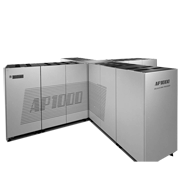The Fujitsu AP1000, announced in October 1992, was Fujitsu’s first scalar-parallel supercomputer that was formed by connecting general-purpose workstations together with a high-speed network. The AP1000 was a distributed-memory, highly parallel computer built from between 16 and 1,024 processing elements called cells. The network connecting the cells was called T-Net, which had a 2D torus topology.
As network technology grew more sophisticated, Fujitsu developed a low latency, high-throughput cell network to improve inter-processor communication performance and used hardware components (routing controllers) for message handling to increase speeds. These two factors allowed the AP1000 to parallel-process operations with large volume cells. Fujitsu established its basic technology for scalar-parallel supercomputers with the AP1000 and continued this technology in the AP3000.
| Introduced | October 1992 |
|---|---|
| No. of cells | 16-1024 |
| Cell processor | SPARC IU + FPU(25MHz) (*1) |
| Memory capacity | 16 MB/cell |
| Cell-connecting network | T-Net (25 MB/s, four channels) |
(*1)FPU: Floating-point unit or floating-point-number processing unit.
The specifications above were correct at the time the products were announced. Some specifications were later revised due to product upgrades.


